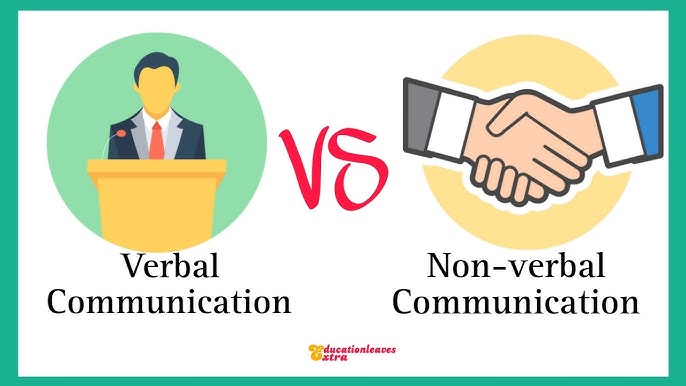Introduction.

Nonverbal communication is a crucial aspect of human interaction that often goes unnoticed but plays a significant role in conveying messages, emotions, and intentions. While words carry meaning, nonverbal cues can enhance or contradict those words, making it essential to understand and harness the power of nonverbal communication in our daily interactions. This article explores the various forms of nonverbal communication, their impact, and how to effectively use them to improve communication skills.
1. Defining Nonverbal Communication
Explanation: Nonverbal communication encompasses all forms of communication that do not involve words. This includes body language, facial expressions, gestures, posture, eye contact, and even tone of voice.
Example: A smile can convey happiness or friendliness, while crossed arms may suggest defensiveness or discomfort.
Strategy: Become aware of your own nonverbal cues and those of others in your interactions to better interpret and respond to messages.
2. The Role of Body Language
Explanation: Body language is a significant component of nonverbal communication. It includes movements, posture, and physical gestures that can convey confidence, openness, or discomfort.
Example: A person standing tall with an open stance may be perceived as confident and approachable, whereas someone slouching or avoiding eye contact might be seen as insecure.
Strategy: Practice maintaining an open posture and using gestures that reinforce your message, as this can create a more engaging communication environment
3. Facial Expressions: The Universal Language
Explanation: Facial expressions are powerful nonverbal signals that can convey a wide range of emotions, often more accurately than words alone.
Example: A frown can indicate displeasure or confusion, while raised eyebrows may signify surprise or curiosity.
Strategy: Pay attention to your facial expressions and those of others to gauge emotional responses during conversations. This awareness can help you adjust your communication accordingly.
4. Eye Contact: Building Connection
Explanation: Eye contact is a vital nonverbal cue that signifies interest, attentiveness, and confidence. It helps establish a connection between speakers and listeners.
Example: Maintaining eye contact while speaking demonstrates engagement, while avoiding eye contact can signal disinterest or discomfort.
Strategy: Aim for appropriate levels of eye contact in conversations to build rapport and convey sincerity. Be mindful of cultural differences, as eye contact norms can vary across cultures.
5. The Impact of Proxemics
Explanation: Proxemics refers to the use of personal space in communication. The physical distance between individuals can convey intimacy, aggression, or formality.
Example: Standing too close to someone may make them feel uncomfortable, while standing too far away can create a sense of detachment.
Strategy: Be aware of the personal space preferences of others and adjust your proximity based on the context of the interaction to foster comfort and connection.
6. Gestures: Enhancing Meaning
Explanation: Gestures are purposeful movements of the hands or body that can emphasize or complement verbal messages. They can vary widely across cultures and contexts.
Example: Nodding while listening can indicate agreement, while pointing can direct attention to a specific subject.
Strategy: Use gestures to reinforce your message, but be cautious of cultural differences in gestures to avoid misunderstandings.
7. Tone of Voice: The Hidden Message
Explanation: The tone of voice, including pitch, volume, and intonation, can significantly alter the meaning of spoken words. It often conveys emotions and attitudes that words alone cannot express.
Example: A sarcastic remark may sound cheerful in tone but carry a completely different meaning than the words used.
Strategy: Be mindful of your tone when speaking. Practicing varying your tone can enhance the emotional impact of your message.
8. Cultural Differences in Nonverbal Communication
Explanation: Nonverbal communication can vary widely across cultures, leading to potential misunderstandings. Gestures, facial expressions, and body language may hold different meanings in different cultural contexts.
Example: In some cultures, direct eye contact is seen as a sign of confidence, while in others, it may be viewed as disrespectful.
Strategy: Educate yourself about the cultural norms of those you communicate with to foster better understanding and avoid misinterpretations.
9. Nonverbal Communication in Professional Settings
Explanation: In professional environments, nonverbal communication can greatly impact perceptions of leadership, teamwork, and credibility. Being aware of nonverbal cues can enhance workplace interactions.
Example: A manager who maintains open body language and positive facial expressions can create a more welcoming atmosphere for team discussions.
Strategy: Cultivate awareness of your nonverbal communication in professional settings. Use it to convey confidence and openness while also interpreting the cues of your colleagues.
10. Developing Nonverbal Communication Skills
Explanation: Developing strong nonverbal communication skills involves self-awareness, observation, and practice. Improving these skills can lead to more effective interactions and enhanced relationships.
Example: Attending workshops on body language or participating in public speaking events can help individuals refine their nonverbal communication abilities.
Strategy: Regularly reflect on your nonverbal communication in various contexts and seek feedback from trusted friends or colleagues to identify areas for improvement.
Conclusion.
Nonverbal communication is a powerful and often overlooked aspect of human interaction. By understanding its components—such as body language, facial expressions, and eye contact—you can enhance your communication skills and foster deeper connections with others. Awareness of cultural differences and the ability to adapt your nonverbal cues to different contexts will further improve your effectiveness as a communicator. Embrace the power of nonverbal communication, and watch as it transforms your relationships, both personally and professionally.


You must be logged in to post a comment.